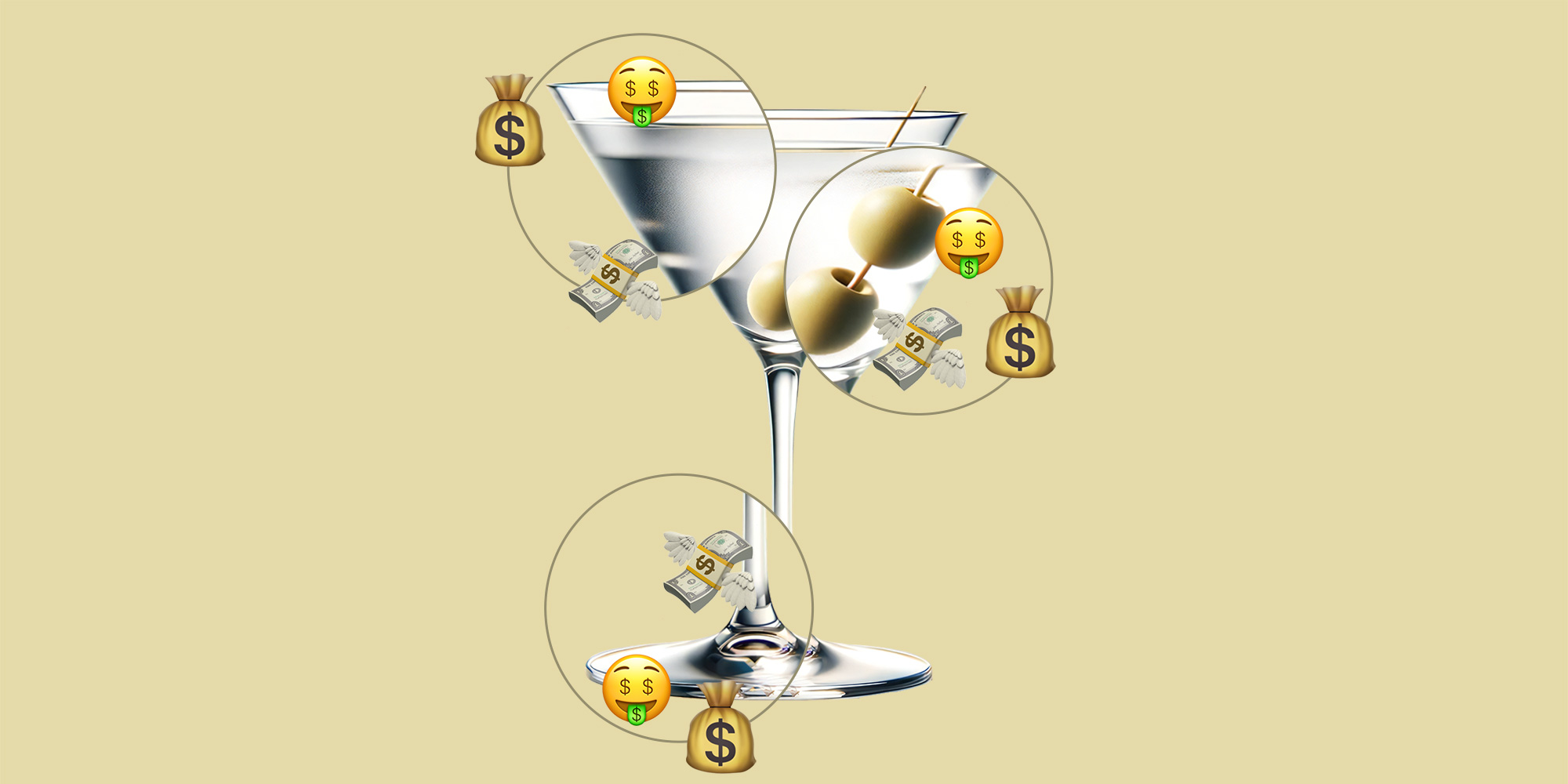
A classic Martini carries several cues that convey sophistication and elegance. The timeless angular glass. The glassy liquid. The garnish’s pop of color. But behind the scenes, all these enticing little details stem from something unseen by guests as they sip the drink with pinkies extended: the bar’s cash flow.
The cost of the glassware, the price of the liquor, the wage paid to the person that kept the glass cold until the last possible moment and built the drink: these are the elements that determine the cost of a Martini. It’s a number that must be high enough to make a profit, yet low enough to keep customers happy. Whether a bar can hit this target consistently can determine its success or even its survival. This target can also look wildly different in an expensive city like New York compared to a relatively cost-effective community like Phoenix.
So, let’s take a peek behind the curtain and find out why your Martini costs what it does. We asked five different venues in five different cities to break down exactly what it costs them to pour a classic Martini. Here are the details, according to the staff that knows the budgets best.
New York City
Venue: The Up & Up
Price of Martini: $20
Breakdown
Ingredients: $2.87
Labor: $6.52
Rent: $2.41
Liability insurance: $0.65
Credit card fees: $0.54
Operating expenses: $6.01
Total cost: $19.00
Profit: $1.00
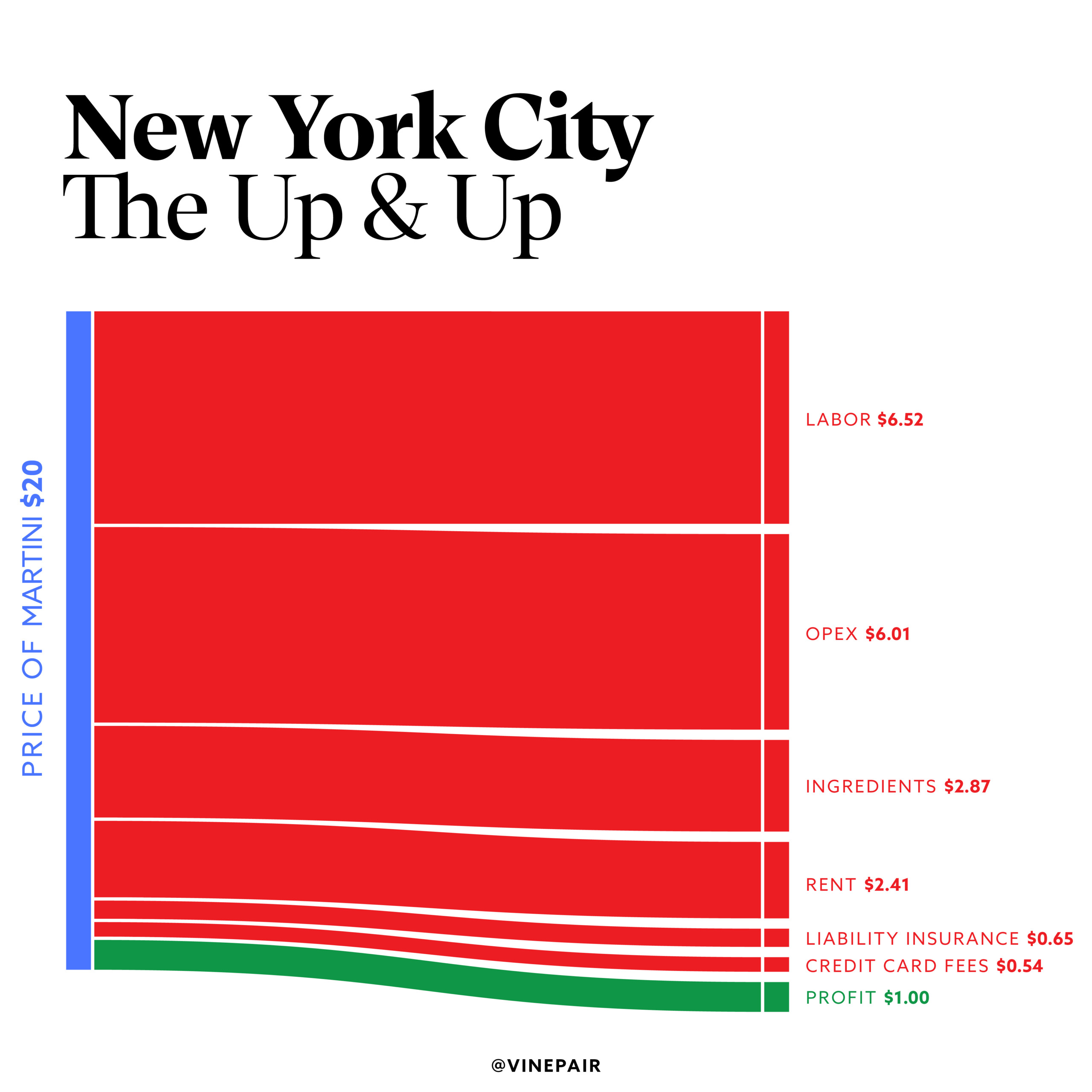
Getting a Martini in a cocktail bar is expensive in Manhattan. This is not a matter of greed, but necessity. The hefty overhead and operational costs of running a bar in the Big Apple leaves places like this Greenwich Village establishment little choice over setting its drink prices higher than other cities. Its co-owner Matt Piacentini knows this better than anyone: he also co-owned the now-shuttered bar Clyde Common in Portland, Ore., where a classic Martini cost $12.
“If I could charge $12 for a Martini and still make it in this city, I would,” he says. “Unfortunately, no one is going to lower prices for what I need, so I can’t drop my prices.”
While Piacentini can’t lower his Martini’s cost, he does add value by creating an atmosphere that leads to a warmer, more intimate visit by way of subtraction — he’s dropped the bar’s seating capacity from 52 to 32 over the years. This led to price adjustments to maintain profit margins, but it’s a trade-off that guests don’t mind.
“We’ve made our changes based on what customers have told us what they want, both verbally and with their business,” he says. “They were willing to pay a higher price for drinks in exchange for a better space.”
Charleston
Venue: Coterie
Price of Martini: $14
Breakdown
Ingredients: $2.80
Labor: $4.20
Rent (including state liability insurance): $1.40
Other insurance: $0.28
Miscellaneous overhead: $2.10
Total Cost: $10.78
Profit: $3.22
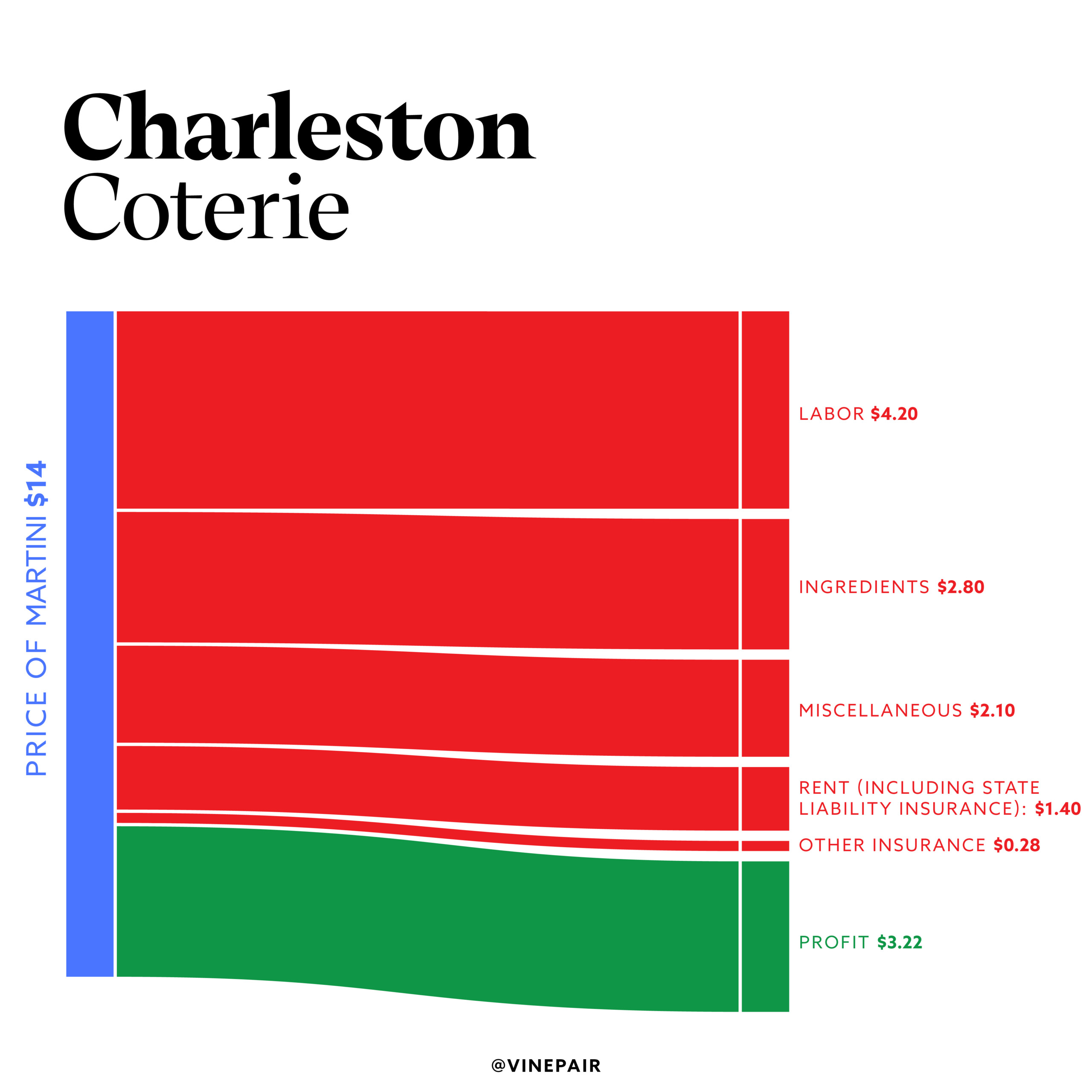
A $14 Martini would be a steal in most major cities. Hell, it’s even a solid price in Charleston, where some fancy spots charge anywhere between three to five dollars more. Yet according to Coterie owner and operator Jeremy Buck, some locals still complain about the bar and restaurant’s set price. When this occurs, Buck may talk to them about the driving forces behind the number, such as their use of elevated well spirits and what he dubs The New York Pour: 2 ounces of booze in the drink instead of the more standard 1 ½ ounces.
“It’s surprising when they complain,” he says. “We’re not trying to swindle anyone. We’re just trying to run a business.”
For Buck, part of running the business means dealing with increasingly tighter profit margins. In addition to rising operational and overhead costs, he also must factor in the insurance costs connected to a state law that requires all South Carolina businesses serving alcohol to carry a liability policy at a minimum of $1 million. The menu’s alcoholic offerings play a key role in managing these costs, accounting for as much as 40 percent of its weekly sales. While the restaurant makes a tidy profit with its Martini sales, how much it impacts the venue’s bottom line varies.
“It really depends on how much we sell,” Buck says. “If you have just one person ordering one Martini a night, it’s not going to do much. We’re just fortunate that people like their Dirty Martinis.”
Los Angeles
Venue: Accomplice Bar
Price of Martini: $16
Breakdown
Ingredients: $1.55
Labor: $3.68
Rent: $3.75
Glassware: $6.30
Total Cost: $15.28
Profit: $0.72
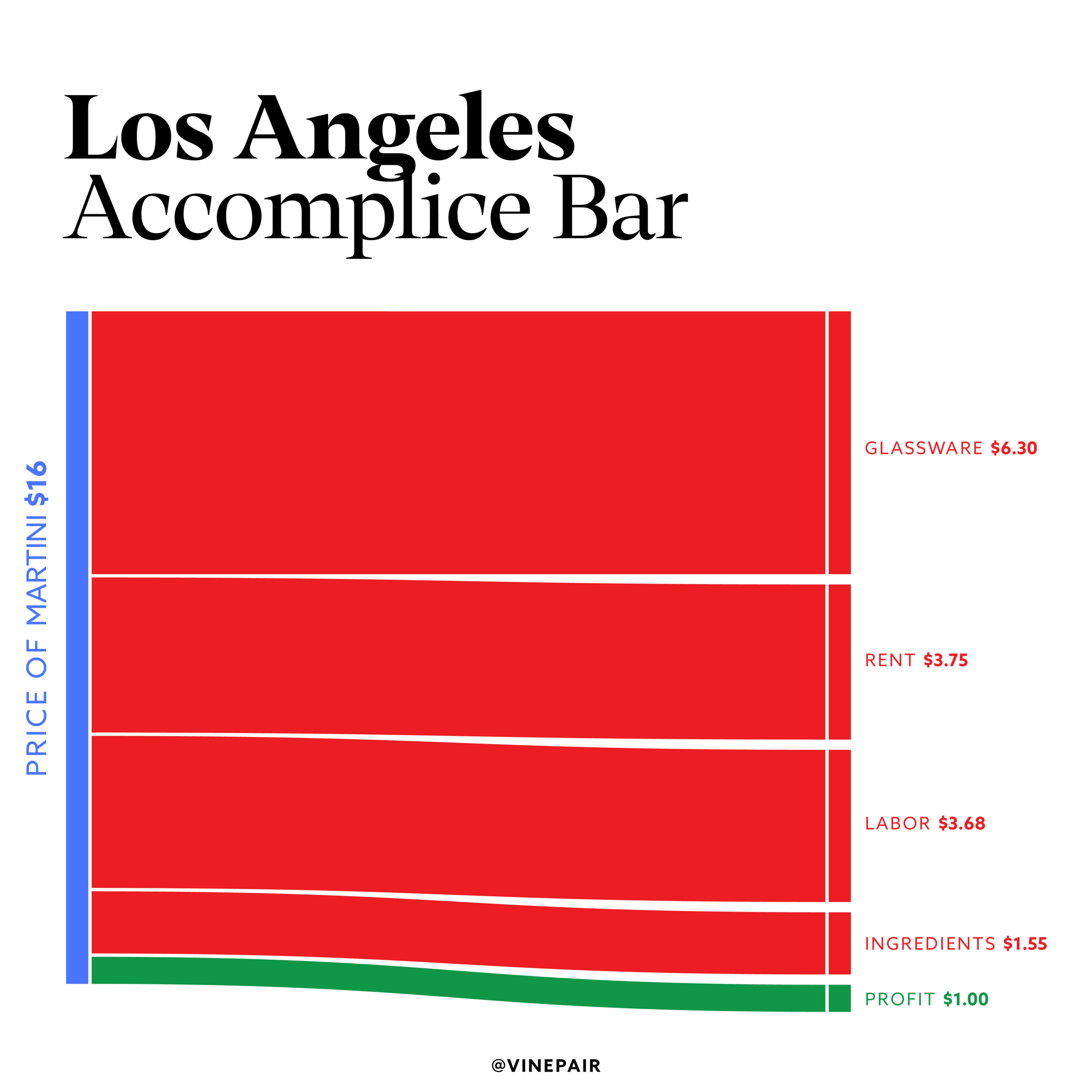
A Martini’s simplicity makes it a customizable cocktail, and at Accomplice Bar, these adjustments can impact profitability. If a guest chooses a top-shelf spirit or a gin with a particularly unique flavor profile, their bartender may adjust the Martini’s build to highlight its characteristics, thus changing the pour cost (the percentage of a drink’s cost compared to overall bar sales.) While this can bump the cocktail’s price up by a couple bucks, that doesn’t mean the bar’s making more money.
“The ideal pour cost for a Martini for us is about 16 percent,” explains Accomplice Bar beverage director Ramsey Musk. “If someone orders a high-end gin like Monkey 47, the pour cost will jump to 22 percent. It’s not going to be a loss, but we’ll make less profit.”
Musk’s commitment to preserving the bar’s neighborhood vibe keeps him from raising Martini prices to match the city’s fancier venues, even though that does tighten his margins. He’s also inserted a few buffers in his economic strategies to offset increases in labor and liquor costs when they do occur.
“I’ll try to find price increases in other ways before raising the drink’s standard cost,” he says. “We’ll raise prices on our happy hour menu, but not by a crazy amount. That way, it doesn’t affect the customers as much.”
Phoenix
Venue: Little Rituals
Price of Martini: $15
Breakdown
Ingredients: $1.80
Labor: $4.20
Rent: $1.50
Insurance: $0.45
Operating expenses: $1.20
Marketing: $0.90
Credit card fees: $0.38
Administrative costs: $1.35
Management fees: $.45
Total Cost: $12.23
Profit: $2.77
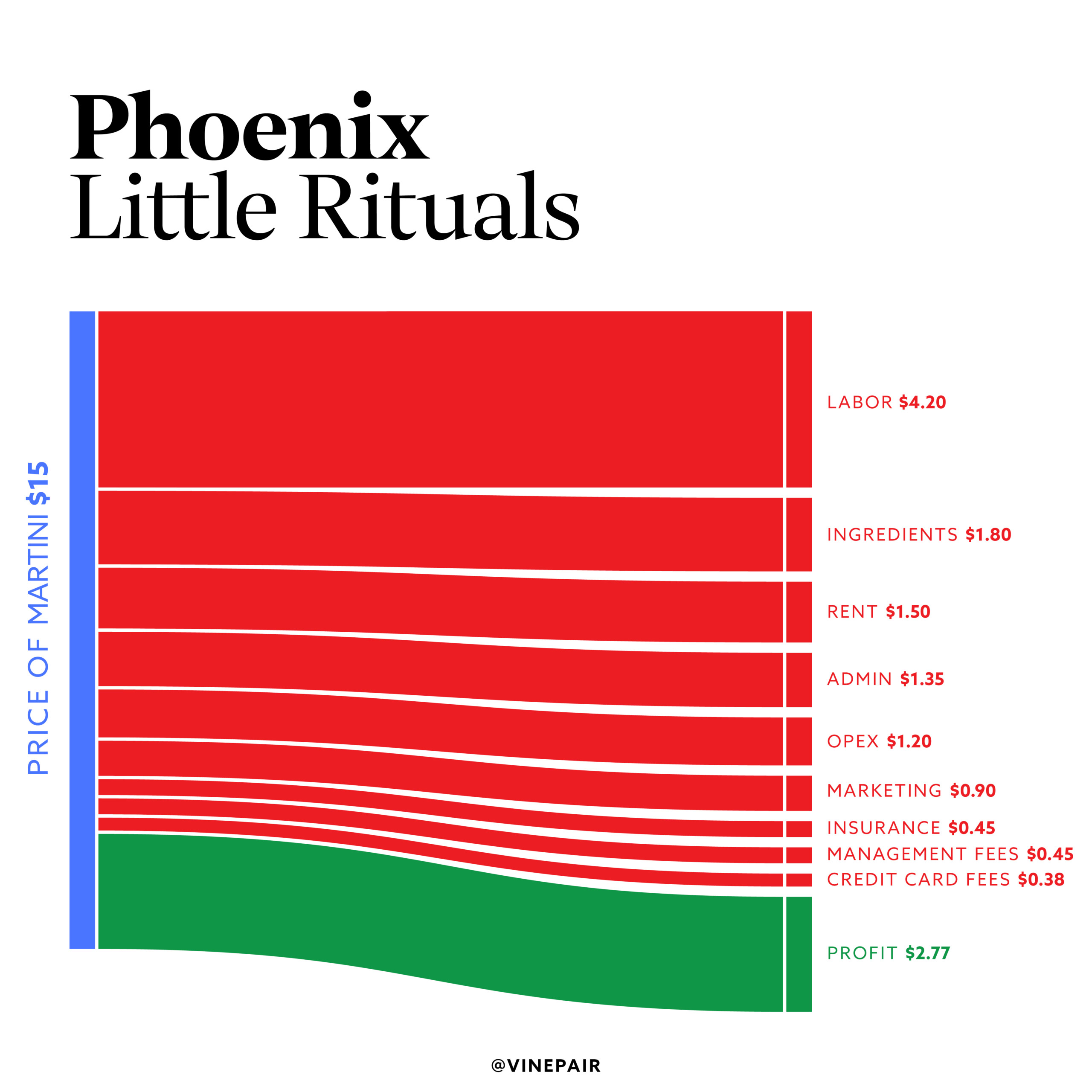
Costs rise, but covers usually don’t. That’s the hard reality of operating a bar. The now-common practice of customers leaving tips with credit cards instead of cash is another factor driving that rise, as it increases the establishment’s tax burden. There’s also occupancy costs like rent, maintenance, and potential fees to restaurant management companies to consider. However, the Martini’s simple build provides this downtown Phoenix hotel bar a bit of budget relief.
“It’s one of the more economical drinks we make if we use a house spirit like Fords Gin,” says Little Rituals proprietor and bar director Aaron DeFeo. “A normal 5:1 build of 2 ½ ounces gin, ½ ounce vermouth, and three dashes of orange bitters has a total cost of $1.50 per drink. Add a garnish, and it’s $1.75. That’s a good value proposition, and it helps to mitigate labor costs.”
There have been incremental price increases for the Martini over the years, but these bumps substantially lag behind the dramatic increases in costs to liquor and labor. “If we raised the prices like that, our Martinis would be $30,” DeFeo explains. He also notes that his patrons haven’t ever complained about the Martini’s price when it’s gone up. At the same time, he’s keenly aware that he must keep the price within a certain range when an increase does happen.
“Martini drinkers have a Rolodex in their head on Martini prices around the city,” he says. “Our Martinis are competitive with the market. If it was over $20, our customers would smell a rat.”
Chicago
Venue: Club Lucky
Price of Martini: $16
Breakdown
Ingredients: $3.23
Labor: $4.64
Mortgage: $0.86
Food: $4.16
Supplies: $0.49
Miscellaneous costs: $0.93
Total Cost: $14.31
Profit: $1.69
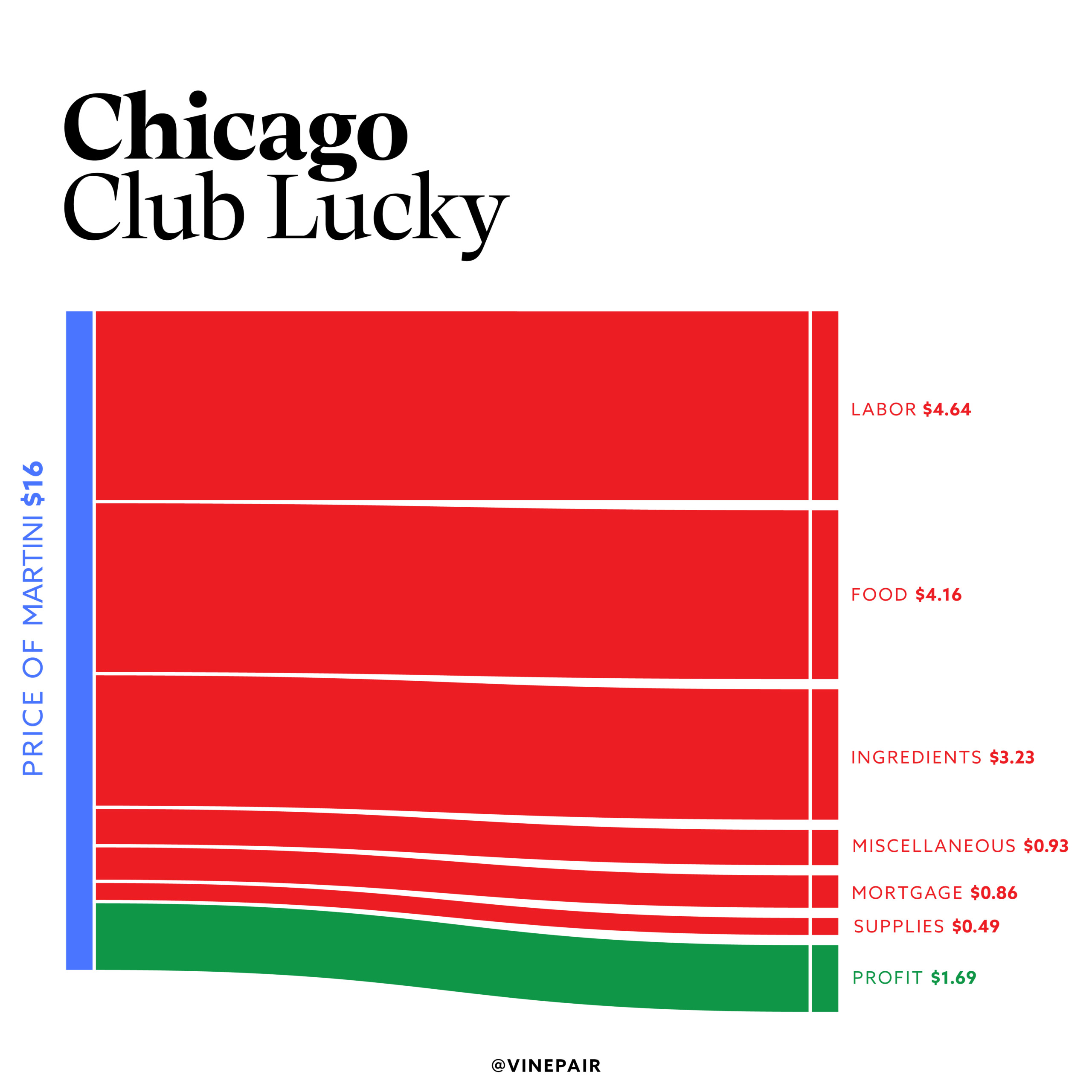
The goal of this neighborhood Italian joint’s bar program is to serve customers a stiff drink for cheap. Its Martinis are a couple dollars less that some of the city’s award-winning spots, and they deliver serious bang for their buck: Each drink features 5 ½ ounces of gin or vodka as opposed to the standard 2 to 3 ounces. That’s a lot of booze, and booze costs money. Still, the establishment makes gains on the drink because of the sheer volume of sales.
“We average 500 drink orders a night, and 350 of those are Martinis,” explains Club Lucky bar manager Tim Matsas.
The Martini’s set price allows them to make a modest profit on each cocktail after labor, operations, and overhead costs. It’s enough of a gain to keep the prices steady, even if Matsas knows that a slight bump in the price could help them breathe a little easier.
“Could we charge more for our Martinis? You bet your ass we could,” he says. “But we’re a neighborhood spot with lots of regulars looking for a stiff drink for a reasonable price. We don’t want to gouge them.” The few complaints about the price Matsas does get tend to come from young drinkers used to grabbing beers and shots at dive bars, but he views those complaints as opportunities for education.
“They’re young, so it’s important to teach them cost economics right off the bat if they’re going to be future customers,” he says. “Usually, they appreciate the explanation.”
The article The Economics of a Martini at 5 Top Bars, Visualized appeared first on VinePair.







